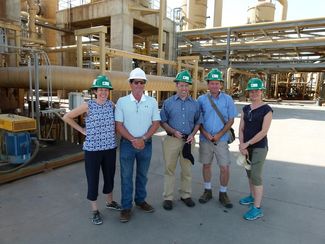Salton Sea - Ecologists back Geothermal
Last updated 7/7/2016 at 8:30am

Courtesy of Andrea Jones
Audubon California visits Featherstone Plant, the only geothermal plant to be built off the Salton Sea resource in the last 20 years.
Audubon California, states that their mission is to 'conserve and restore natural ecosystems, focusing on birds, other wildlife, and their habitats for the benefit of humanity and the earth’s biological diversity', which you would assume would make a visit to a Geothermal plant and odd choice.
The John L. Featherstone Plant at the Salton Sea welcomed the team to the only new geothermal plant built in the area, over the past 20 years, to find out why such plants could offer major environmental benefits to the area and could work in-conjunction with the recovery efforts which focus directly on allocating money for habitat restoration efforts.
Geothermal is currently 22 percent of California’s renewable energy portfolio and able to produce greater amounts of energy on a small footprint then Solar.
“One of the problems with Solar and wind is that they can leave gaps in electricity production at night or when the wind isn’t blowing,” explained Garry George, Audubon California’s Renewable Energy Director. “By comparison, geothermal provides a stable baseload.”
Although it is hard to calculate as a rule just how much more energy can be produced in the same-sized area by geothermal versus Solar, a comparison of local electricity production can give a good estimate. By comparing Featherstone to a nearby Solar project, the difference is clear. The geothermal plant can produce about 1.2 megawatts per acre of land while the Solar complex can produce about 0.19 megawatts per acre, making geothermal more than six times as land-efficient as local Solar facilities.

With the good comes the bad and Geothermal electricity production does still generate mineral byproducts. Sometimes these substances have to be deposited into hazardous waste sites, but plants like Featherstone are increasingly working to re-purpose the waste into useful concrete-like products. Despite the fact that production remains a more costly electricity option, the cost of habitat restoration that Solar development in delicate ecosystems like the Salton Sea would incur, geothermal looks to be a viable option.


